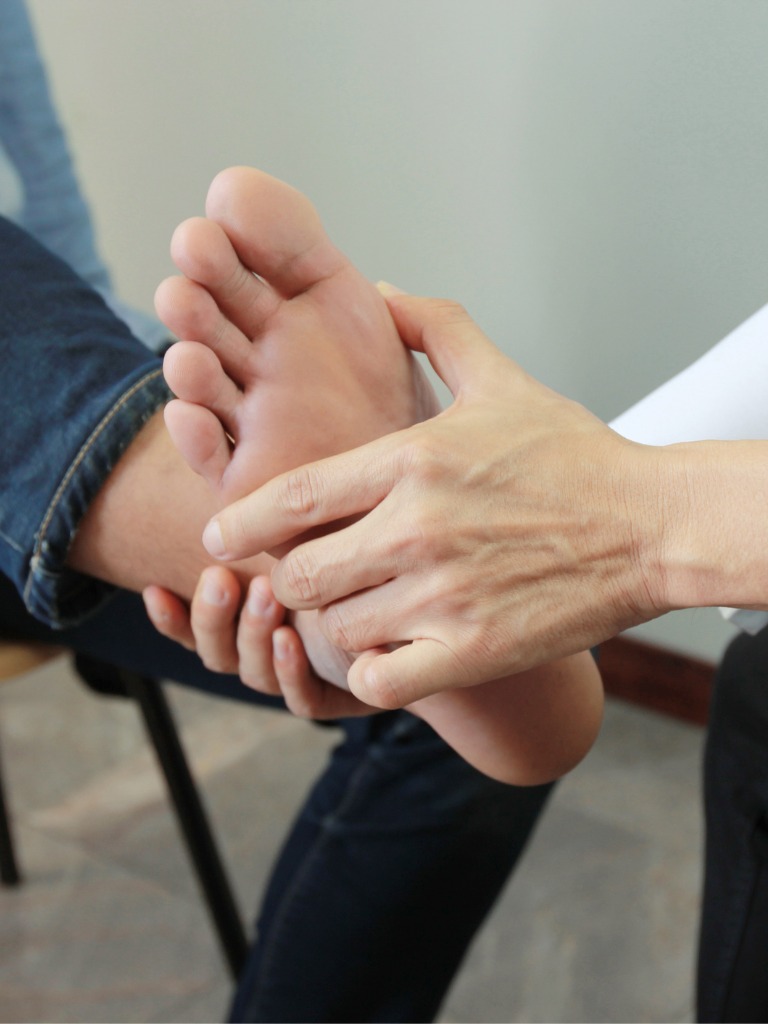Diabetic foot ulcers are one of the most serious complications of diabetes, affecting roughly one-third of patients at some point in their lives. These open sores, often found on the bottom of the foot, can be slow to heal and may lead to severe infections if left untreated. In the worst cases, untreated ulcers can result in the need for amputation.
However, the good news is that with the right care and attention, many diabetic foot ulcers can be prevented. Understanding the risk factors and taking proactive steps to protect your feet are essential for maintaining your foot health and avoiding long-term complications.
What are Diabetic Foot Ulcers?
A diabetic foot ulcer is an open wound that typically forms on the bottom of the foot. These ulcers develop due to a combination of factors commonly associated with diabetes, including poor circulation, high blood sugar levels, and nerve damage (diabetic neuropathy).
When the nerves in your feet are damaged, you may not feel pain from small cuts, blisters, or pressure points, allowing them to worsen over time. Additionally, poor circulation can slow down the healing process, making even minor injuries more dangerous.
What Causes Diabetic Foot Ulcers?

There are several reasons why diabetic foot ulcers can develop:
- Poor circulation: Diabetes can narrow the blood vessels in your legs and feet, reducing blood flow. Without enough oxygen and nutrients, wounds heal slowly.
- Nerve damage: Neuropathy can cause a loss of sensation, meaning you might not notice a small injury until it becomes infected.
- Foot deformities: Conditions like bunions, hammertoes, or flat feet can create pressure points that lead to skin breakdown and ulcers.
- High blood sugar: Elevated blood sugar levels weaken your immune system, making it harder for your body to fight infections or heal wounds.
8 Tips to Prevent Diabetic Foot Ulcers
1. Inspect Your Feet Every Day
One of the most important steps in preventing diabetic foot ulcers is inspecting your feet daily. Nerve damage caused by diabetes can make it difficult to feel pain or discomfort, so you might not notice injuries that could lead to ulcers.
Be sure to check for:
- Cuts, blisters, or sores
- Redness, swelling, or changes in skin color
- Dry or cracked skin, especially around the heels
- Warmth or unusual temperature changes in your feet
If it’s hard for you to see the bottoms of your feet, use a mirror or ask someone for help. The earlier you catch any signs of trouble, the quicker you can get the treatment needed to prevent an ulcer.
2. Wash and Moisturize Your Feet Daily
Good hygiene is crucial in preventing infections that can lead to ulcers. Make it a point to wash your feet every day using warm (not hot) water and mild soap. Be sure to dry your feet thoroughly, especially between your toes, as moisture can increase the risk of fungal infections.
Once your feet are clean, apply a moisturizing lotion to prevent dry, cracked skin that can lead to ulcers. However, avoid applying lotion between the toes, as excessive moisture in this area can encourage fungal growth.
3. Wear Properly Fitting Shoes
Footwear plays a big role in preventing ulcers. Ill-fitting shoes can create pressure points or cause blisters, which can quickly turn into open sores. Diabetic patients should always wear shoes that:
- Provide ample support and cushioning
- Are not too tight or too loose
- Have a wide toe box to prevent rubbing or squeezing the toes
It’s also a good idea to wear seamless socks to avoid friction. Diabetic shoes and inserts are designed to minimize pressure points and reduce the risk of injury, so consider talking to your doctor or podiatrist about specialized footwear options.
4. Trim Your Toenails Properly
Improper toenail trimming can cause ingrown nails, which can lead to infection and ulcers. Trim your nails straight across to avoid creating sharp edges that might dig into your skin. If you have trouble trimming your nails or notice any signs of infection, it’s best to see a podiatrist for help.
5. Control Your Blood Sugar Levels
Keeping your blood sugar levels in check is one of the most effective ways to prevent diabetic foot ulcers. High blood sugar can lead to poor circulation, which slows down the healing process and weakens your immune system. Work with your healthcare provider to monitor and manage your blood sugar levels through medication, diet, and exercise.
6. Avoid Smoking
Smoking can impair blood flow and reduce oxygen delivery to your feet, making it more difficult for wounds to heal. Quitting smoking can greatly improve your circulation and reduce your risk of developing ulcers.
7. Stay Active to Promote Circulation
Physical activity helps improve blood flow to your legs and feet, which is essential for preventing ulcers. Activities like walking, swimming, or cycling can help keep your circulation healthy. If you’re sitting for long periods, make sure to move your feet and legs regularly to keep the blood flowing.
8. See a Podiatrist Regularly
Even if you don’t have any symptoms, regular foot exams by a healthcare professional are important for catching problems early. Schedule regular visits with a podiatrist, who can check for signs of nerve damage, poor circulation, or deformities that could increase your risk of ulcers. They can also offer advice on proper footwear and preventive treatments.
Prevent Diabetic Foot Ulcers with Expert Care
Preventing diabetic foot ulcers requires daily attention and proactive care, but it can significantly reduce your risk of serious complications. If you’re concerned about your foot health or need help managing your diabetes, the team at Sheehy Ankle & Foot Center is here to help.
We specialize in diabetic foot care and can provide personalized advice to help you keep your feet healthy. If you notice any signs of injury or changes in your feet, don’t wait — schedule an appointment with us today to get the care you need before small issues become big problems.
